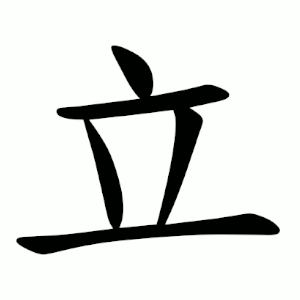立
- to stand;
- to make erect;
- to establish;
It represents the concept of standing upright or setting something up.
Etymology
It is a compound of 大 (big/large) and 一 (one), where the pictogram of a person (大) is combined with a horizontal stroke 一 representing the ground, symbolizing a person standing on the ground. This character is both a pictogram and an ideogram (a combination of meaning and form).
Originally, an ancient form 𡗓 (called 츠) was used, but from the Small Seal Script era, the variant form 立 appeared, eventually replacing 𡗓 and becoming the standard.
Interestingly, the mysterious ancient character 𰀆 with an added dot becomes 立. When the character 立 is combined with 十 (ten), it forms 辛 (meaning “bitter” or “spicy”). 辛 originally represented the shape of a needle used to tattoo criminals or slaves and is also a pictogram combined with the ideogram 一 (a mark indicating piercing).
Characters with 立
- 卜廿 (YT)
- ⿱ 亠 䒑
